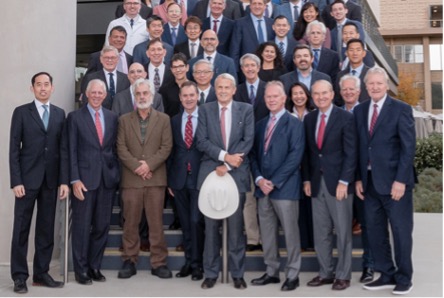D.Craig Miller, MD,
Stanford University, Palo Alto, Ca, 22.11.2024
Dear Craig, dear colleges, ladies and gentlemen,
Thank you for inviting me to this very special event dedicated to a very special person, Craig Miller.
On my flight to San Francisco, I read a biographie on Ludwig Aschoff, a German pathologist early in the last century. I was curious about his view on the pathology of aortic disease, a topic, I have been very interested in for quite some time. Many scholars visited Aschoff in Freiburg, vice versa did he pay many visits to colleges all over the world, East and West. 100 years ago, he visited Johann Ophuels, pathologist and first Dean of the Stanford University School of Medicine. Ophüls had inaugurated the SUMC Bulletin In Volume 1, No 1, he published his own article entitled „Arteriosclerosis and ist relation to infectious disease“. At that time, textbooks would indeed categorize atherosclerosis as an infectious disease, close to todays description as a primarily inflammatory disease of the blood vessel wall.
40 years ago and 80 years after Aschoff`s visit, I started my research fellowship here at Stanford. Hans Borst, my chief in Hannover, wanted to send me to Hershey to work on artificial hearts. I visited the place, but was not convinced about the surgical input. Back home, I heard a speach from Norman Shumway during a Cardiology meeting in Brussels. He reported on the early Stanford experience on heart and lung transplantation. Pictures of the team included young, contemporary surgeons at Standford, turning into prestigous guests present here, tonight, like Bruce Reitz, Bill Baumgartner and Phil Oyer. I was flashed, I wanted to take part in that adventure, I wanted to work for Norman Shumway. We re-routed my travel and I started my job in the transplant research lab, feeling like being on the Mount Everest of cardiac surgery. However, the first surgeon I met when entering the office was a tall man with cowbow head and boots. I was scarred, because I thought that he must be the sherrif, and for a brief moment, I wished, I had taken the job in Hershey.
The transplant lab was very busy, we worked on like any species coming across, rats, dogs, primates. During my year (1983/84), we found that the lung not necessarily rejects simultannously with the heart, and – by a laboratory accident – developed a concept for donor organ preservation in lung transplantation. Our method using Euro Collins solution, detected by a non-functioning infusion system, would become the standard clinical concept for donor lung preservation worldwide for the next 20 years. Based on the pioneering work on 2 primates by Bruce and Bill 5 years earlier (they had named them Mom and Gustav), we were also able to publish the very first report on long-term function and histology of both the heart and the lung after combined transplantation.
Long-term function, today called sustainability, had been a surgical goal, characteristic for Stanford cardiovascular surgery. Along that line, Craig came up to me asking wether I could help him with some long-term data after surgery for acute type A dissections. Of course, I would, since aortic disease was a prime topic in Hannover, as well. Craig guided me through the principles of excellent research on clinical data, including actuarial survival and statistics, including also multivariate analyses and graphical depiction of results. Thanks to Craig, I received the opportunity for a first presentation at the American Heart Meeting, and a first publication in „Circulation“. I was young and without any experience, but he let me do it…
So, a number of publications resulted from this year at Stanford, experience secured on paper. Equally important for me, however, was the experience I took home, in my mind and in my heart. Today, I would call it the „Stanford spirit“. In three categories, this spirit coined my then starting career as an academic surgeon;
With these three orders, I returned to Germany. I am glad that – as an academic teacher - I was able to live along these orders, and teaching the next generation in this spirit. Since so many young European fellows travelled to Stanford at the time, that spirit spread accross the old continent. For Germany, it reminds me of the title of an invited guest lecture of my mentor, Hans Borst; „Hands accross the ocean“, which he read at the AATS in 1985. His last slide depicted a pie, decorated with the American flag. One piece was partly pulled out, showing the German flag inside. Borst stated at that time:“ A piece of the American surgical pie has a German filling. Likewise, I would state now, at the end of my surgical career, that the German pie of cardiac surgery has a Stanford filling.
Craig, I wish you all the best for the future, thanks for all your help in the past, and please, stay in contact.
Axel
Scientific curiosity to clinical innovation
Academic accuracy to honesty, longterm , Germany and Europedata, sustainabilityx
Acaxmic enlightment, career, next generation amplify, multilplyslice with
Stanford spirit
Borst – Hands accross the ocean smerican pie, slice with German filling
German pie slice with Stanford filling
